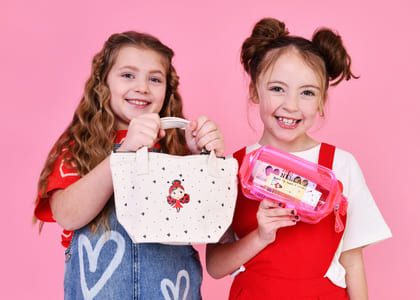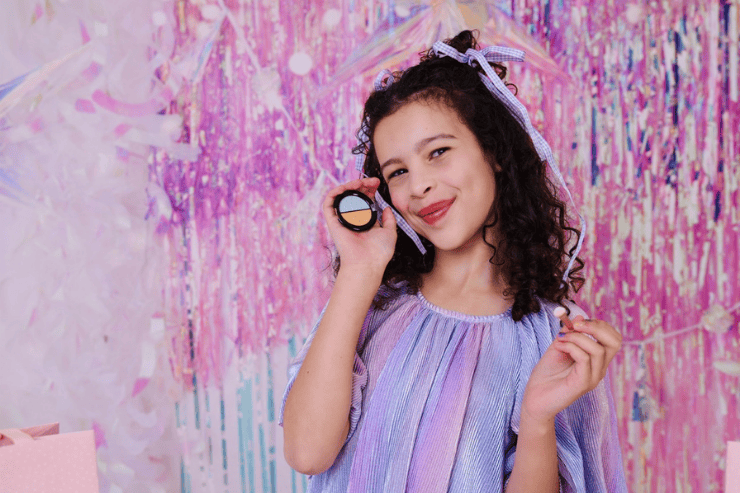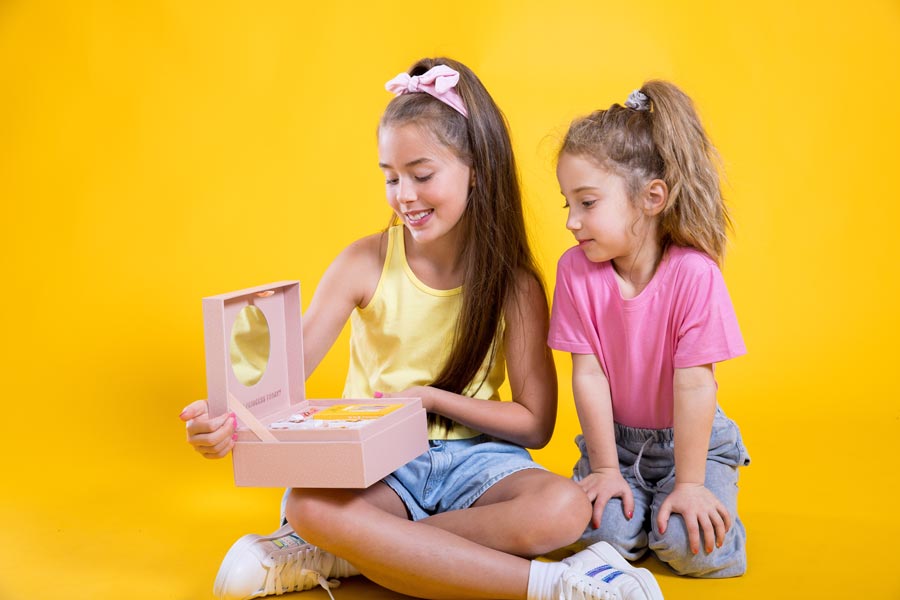The Complete Guide to Non-Toxic Makeup For Kids
Key Takeaways:
Top Picks: Natural and Safe Makeup for Kids
Some child-friendly makeup products for kids are –
1. Miss Nella Non-Toxic Makeup for Kids – Non-toxic, water-based, organic, free from harsh chemicals and easy to remove without acetone.
2. Klee Naturals Makeup Kit – Made with minerals and botanicals, free from parabens and artificial dyes.
3. No Nasties Kids Makeup – Vegan-friendly with recyclable packaging and kid-safe colours.
These brands are crafted specifically for children and contain no harmful chemicals, making them a go-to choice for parents.
| Harmful Chemical | Why It's Unsafe | Safer Alternative |
|---|---|---|
| Phthalates | Hormone disruptor, allergy risk | Coconut oil, beeswax |
| Formaldehyde | Skin/respiratory irritant | Vitamin E, plant-based preservatives |
| Toluene | Linked to neurotoxicity | Water-based polish |
| Styrene | Carcinogenic at high levels | Natural mica |
| Parabens | Hormonal effects, possible carcinogen | Grapefruit seed extract |
| Perfume/Fragrance | Triggers asthma and allergies | Fragrance-free |
| Alcohol | Dries and irritates skin | Aloe vera, rose water |
| Palm Oil | Environmental and skin concerns | Shea butter, olive oil |
Why Non-Toxic Makeup is Essential for Kids?
A study for Campaign For Safe Cosmetics said that cosmetic products designed for children contain hidden toxic substances like metals or organic volatile compounds. And you don't want such products to be used by your children, right?Another study by EHP said that kids who use more personal products have higher levels of toxic phthalates in their bodies, which are highly toxic and can alter hormone production.
A Guardian article mentioned, "The results show that the use of skincare products on children are sources of exposure to these chemicals," Bloom said. "What also definitely raises concern is that these products tend to be used frequently and over long periods of time."
Seeing these facts and figures, non-toxic makeup for kids is gaining recognition. The makeup products used by children should encourage their creativity while maintaining innocence. Such items are dermatologically tested, hypoallergenic, chemical-free, and made using natural and gentle ingredients. Perfume-free choices are emphasised to avoid exposure to phthalates, which are common in fragrances.
Why Children Are More Vulnerable?
Children's bodies are more susceptible to the effects of chemicals found in makeup. Their growing, sensitive skin, smaller lungs, and higher surface-to-weight ratio make them more vulnerable to even minimal exposure.
Makeup for Adults vs. Child Friendly Makeup for Kids
While it might seem tempting to let children experiment with adult makeup, it's essential to recognise the differences.
Non-toxic kids' more natural makeup, though less glamorous, offers a fun and responsible way for children to engage with cosmetics, emphasizing the importance of skin care.

Toxic Chemicals to Avoid in Kids’ Makeup
The guide identifies harmful chemicals commonly found in cosmetics, emphasizing the importance of steering clear of them in kids' makeup.
1. Phthalates: Known as plasticisers, phthalates can cause hormonal disruptions and allergies, making them unsuitable for children.
2. Formaldehyde: Used as a preservative in cosmetics, it's a potential carcinogen and can irritate the skin, eyes, or respiratory tract.
3. Toluene: Found in nail polishes, it's a harmful endocrine disruptor linked to neurological effects.
4. Styrene: Used in cosmetics, it can cause irritations and may be a potential carcinogen in high quantities.
5. Parabens: Common preservatives in cosmetics, parabens can obstruct hormone function, and their potential connection to cancer is a concern.
6. Perfume: Fragrances in cosmetics may trigger allergies, asthma, and migraines, making odour-free options preferable for kids.
7. Alcohol: While versatile, alcohol in cosmetics may cause skin issues, making it unsuitable for kids.
8. Palm Oil: Its derivatives in skincare products pose risks, and the guide encourages avoiding them for children due to potential skin issues and environmental concerns.
Getting Started with Safe Makeup for Kids in 5 Steps:
For parents navigating their children's interest in makeup, the guide offers practical steps:
1. Buy Non-Toxic Products: Opt for makeup with minimal, safe ingredients, avoiding harmful compounds.
2. Start with Basics: Gradually introduce water-based nail polish and chemical-free lip balm before expanding to more products.
3. Watch for Skin Reactions: Given children's sensitive skin, choose hypoallergenic products and monitor for any adverse reactions.
4. Consider Skin Type: Address concerns for sensitive or acne-prone skin, emphasizing that skincare involves responsible product use.
5. Promote Healthy Routines: As children grow, guide them toward adult-like makeup with an understanding of basic skincare routines, reinforcing inner beauty over external appearances.
How to Spot Fake "Non-Toxic" Makeup Claims
Prioritise safety above everything when it comes to buying organic makeup for kids. Choose those products that fulfil all the requirements of testing and certifications. USDA Organic, EWG Verified are some certifications which indicate that the products meet the strict standards for ingredient safety and are free from any harmful chemicals. Here are the few steps to follow:
1. Check for Certifications: Trustworthy products often carry recognised safety certifications like EWG Verified, USDA Organic, or Made Safe. These labels indicate that the makeup has passed strict safety and transparency standards. If the product doesn’t have any of these, it might not be as “clean” as it claims.
2. Beware of Greenwashing: Buzzwords like "natural," "eco-friendly," or "non-toxic" are often used to market products as safer than they are. However, without third-party validation or ingredient transparency, these claims are just clever marketing. Always ask: Where's the proof?
3. Read the Full Ingredient List: Flip the packaging over and dig into the full ingredient list—not just the front labels. Ingredients like parabens, phthalates, or artificial dyes should raise red flags. Understanding what's inside is the only real way to know if it's safe for your child's skin.
4. Avoid Fragrance or Parfum: The word "fragrance" may sound harmless, but it often hides a cocktail of synthetic chemicals. These can be irritating or allergenic, especially for kids. Opt for products that are clearly labelled as fragrance-free or use essential oils only.
5. No Age Recommendations? Skip It: If a product doesn't clearly state that it's safe for kids or appropriate for their age, it's best to avoid it. Genuine kid-safe makeup brands design their formulas with younger skin in mind and proudly indicate age suitability right on the label.
Tips to Ensure your child's Makeup Kit is safe
Educate yourself about the ingredients that are used in the makeup products. Read labels carefully.
Opt for brands that prioritise non-toxic, natural and organic materials in the manufacturing of their products, such as Miss Nella, so that they are safer for children's delicate skin.
Let the children know that makeup is meant for only playtime so that they can't misuse the products. Supervise the children when they are using makeup products to ensure proper cleanup after they are done with their activities to maintain skin health.
Conduct a patch test on a small area before its full application.
Teach good skincare practices to children, such as staying hydrated and moisturising.
Conclusion
In conclusion, this guide aims to empower parents to facilitate a safe and positive introduction to non-toxic makeup for their children, emphasising responsible use and self-love from a young age.
This global guide provides general insights into non-toxic makeup for kids. While the information is comprehensive, variations may exist based on regional regulations and individual circumstances.
Thank you for reading. If you found this guide helpful, please consider sharing it with your family and friends.
FAQs
1. What are some trusted brands for child-friendly makeup in UK?
Trusted kids-safe makeup brands include Miss Nella, which offers organic, hypoallergenic products. It is a brand that prioritises safety and uses minimal, gentle ingredients suitable for kids.
2. Is kid-friendly makeup more expensive than conventional makeup?
Kids-friendly makeup can be more expensive than conventional makeup due to the higher cost of natural and organic ingredients, as well as rigorous safety testing. However, the investment is often worth it for the added safety and quality, especially for children's sensitive skin.
3. How should kids non-toxic makeup be stored to maintain its safety and effectiveness?
Kids' non-toxic makeup should be stored in a cool, dry place away from direct sunlight and heat to prevent degradation of natural ingredients. Ensure that containers are tightly closed to avoid contamination and follow any specific storage instructions provided by the manufacturer.
4. How can I differentiate between truly non-toxic makeup and marketing claims?
To differentiate truly non-toxic makeup from marketing claims, check for certifications like USDA Organic or EWG Verified and review ingredient lists for harmful chemicals. Transparent labelling, third-party testing, and reputable brand reviews also help verify the product's safety and authenticity.
5. What should I look for in kids' makeup for sensitive skin?
Make sure to choose makeup for children with sensitive skin that is hypoallergenic, dermatologist-tested, and fragrance-free. Choose makeup that is created without harmful chemicals like phthalates, parabens, and unnatural dyes and instead with natural or organic ingredients.
6. Can I use adult mineral makeup on kids?
It's not recommended. Adult mineral makeup may contain ingredients or pigments not suitable for sensitive children's skin. Always choose products specifically labelled safe for kids.
7. How to check if makeup is safe for kids?
Look for labels like "hypoallergenic," "dermatologist-tested," "non-toxic," and "safe for children." Avoid products with parabens, phthalates, and strong fragrances.
8. At what age can kids start using makeup?
There's no fixed age, but many parents allow light, play-based makeup around the age of 5–7. For regular use, it's best to wait until pre-teen years and always choose safe makeup for children.
Popular posts
Top Picks from Miss Nella: Our Best-Selling Products
Ever wish your child's makeup kit came with a "no mess, no stress" guarantee? Welcome to the world of Miss Nella, where safety meets sparkle, and every makeup product is made with tiny hands and curious hearts in mind. From peel-off nail polishes to fizzy bath bombs and playful perfumes, our best-selling products are more than just products they're magical experiences wrapped in non-toxic goodness.
Why Parents are Choosing Natural Lip Gloss for Their Kids This Winter
Winter brings with it the charm of snowflakes, cosy sweaters, and hot cocoa. But for many parents, it also signals a season of extra care especially when it comes to their little ones' delicate skin and lips. Cold winds, low humidity, and harsh indoor heating can quickly lead to chapped lips in children, causing discomfort and sometimes even painful cracks.
Can Natural Play Makeup Be Both Fun and Safe?
Makeup for children has evolved far beyond simple face paints and glitter. Today, there's a growing interest in natural play makeup products designed specifically for children that prioritise safety without compromising on fun.
Ultimate Gift Guide for 10-Year-Olds: Top picks for Girls
Buying the perfect gift for a 10-year-old can feel like walking a tightrope between cool and practical, fun and meaningful. At this age, kids are no longer little children but they're not quite teens either.





